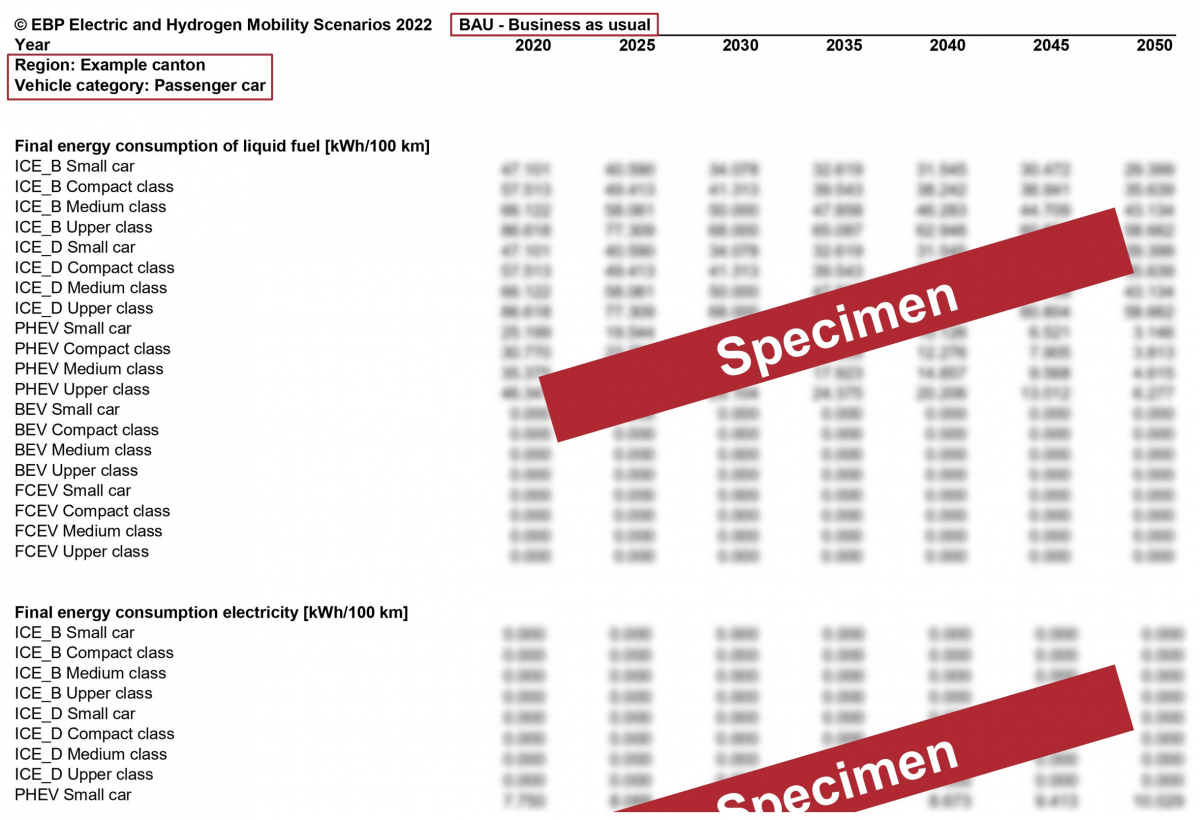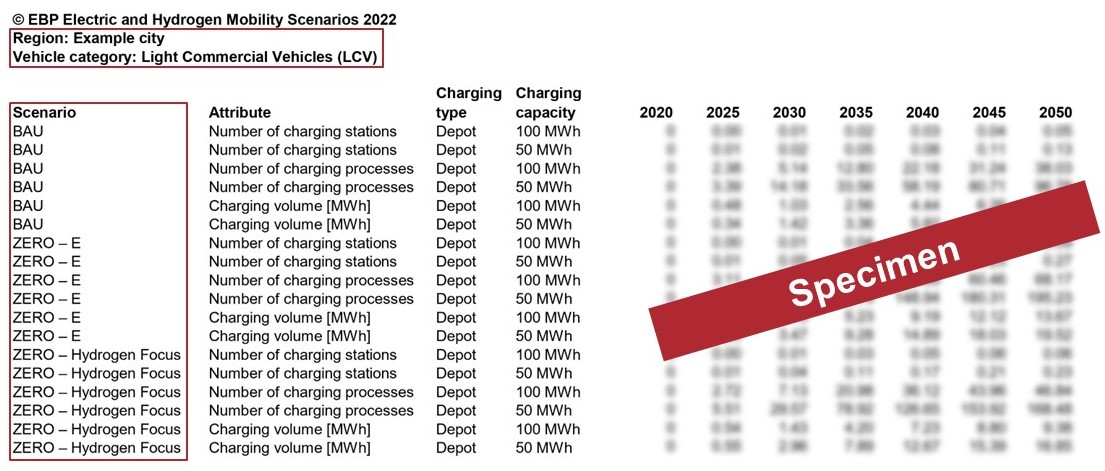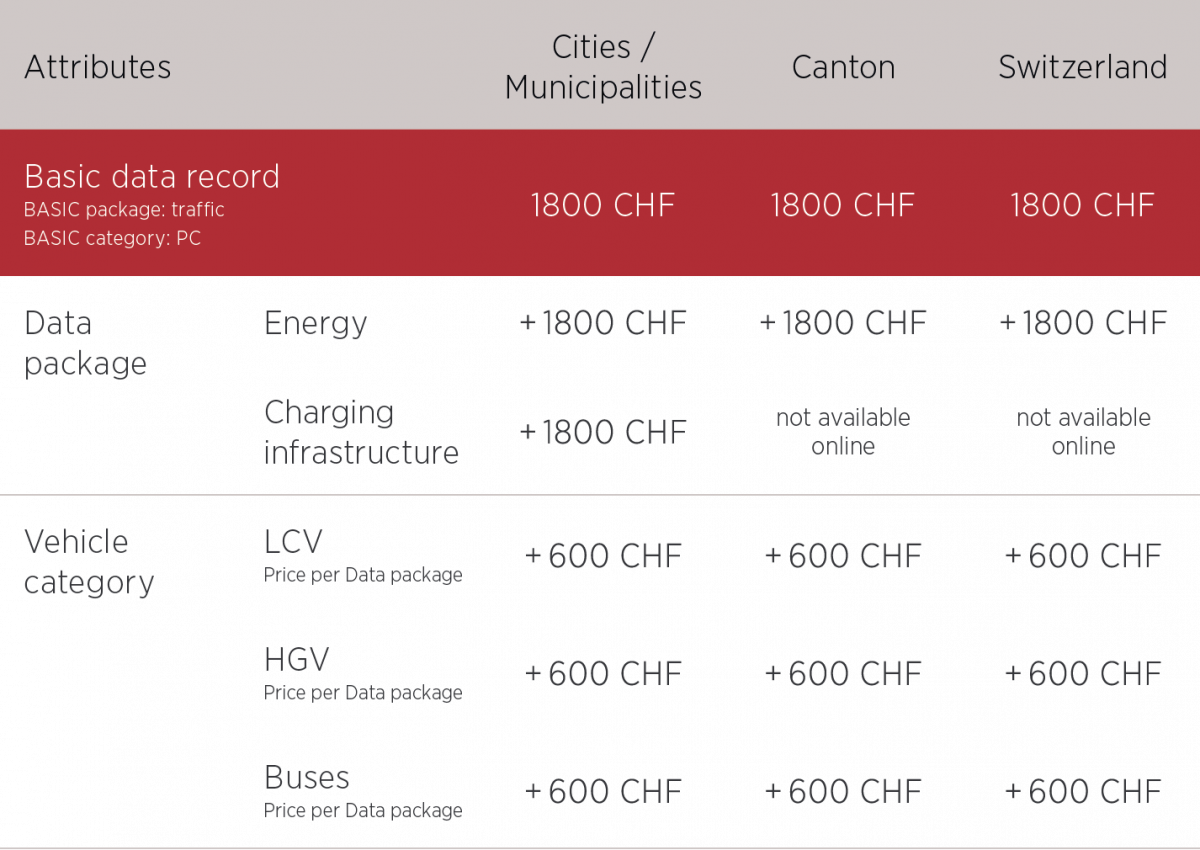The new report “Electric and Hydrogen Mobility Scenarios Switzerland 2050 – Outlook 2024” is now downloadable free of charge (see attachment for download link). The report contains detailed information on system demarcations, assumptions, data sources and a diffusion-theoretical model. The underlying data, which EBP offers for purchase, is market-leading and supports data-based decisions for achieving net-zero goals in the area of electric and hydrogen mobility. Three combinable data packages are available on transportation, energy and charging infrastructure, based on various scenarios and vehicle categories up to the year 2050.
In addition to nationwide data, you can also obtain cantonal and municipality-specific data. You can request the data by different vehicle categories and scenarios up to the year 2050. In addition, we provide you with a detailed background report with the data package.
Be well prepared for the future
The mobility sector is responsible for almost one third of Swiss greenhouse gas emissions. To achieve the climate goal of net zero emissions by 2050, it is therefore necessary to switch from fossil fuels (gasoline, diesel) to sustainable energy sources. Electric cars, as well as hydrogen (fuel cell) cars, play an important role in this. Electric and hydrogen mobility is on the verge of becoming a mass market. At present, however, the charging infrastructure for sustainable vehicles is still underdeveloped. Alongside the growth of electric and hydrogen vehicle sales the available charging infrastructure will have to increase significantly in the next few years.
With the Electric and Hydrogen Mobility Scenarios, we provide the appropriate data basis for well-founded decisions on the topic. So that you are optimally prepared for the future.
About our product:
With the Electric and Hydrogen Mobility Scenarios, we offer you up to three complementary data packages that build on each other. We provide you with information in 5-year steps up to the year 2050.
All data points contain information about the drive categories ICE (Internal Combustion Engine), BEV (Battery Electric Vehicle), PHEV (Plug-in Hybrid Electric Vehicle) and FCEV (Fuel Cell Electric Vehicle), as well as the vehicle categories Passenger cars (PC), Light Commercial Vehicles (LCV), Heavy Goods Vehicles (HGV) and buses. For more information on the drive and vehicle categories, please see our included background report*, as well as our freely available report*.
* Reports are currently only available in German.
Traffic
The traffic data package contains information on the development of motorized traffic up to the year 2050.
The following data points are included in the traffic data package:
- Vehicle stock: in 1000 vehicles
- New vehicle market: in 1000 vehicles
- New registrations per fuel type: in %
- Vehicle stock – dynamic: in 109 vehicle kilometres per year
With an order you will receive an Excel file with one data sheet per scenario. The following example shows how the data set is roughly structured and subdivided:

Please feel free to reach out to our support team if you have any questions about the product.
Energy
The Energy data package can only be purchased in combination with the traffic package above. It contains additional information on energy consumption per fuel.
The following data points are included in the Energy data package:
- Final energy consumption of liquid fuels (diesel & gasoline): in kWh/100 km and in GWh
- Final energy consumption electricity: in kWh/100 km and in GWh
- Final energy consumption hydrogen: in kWh/100 km and in GWh
For nationwide and cantonal data, the data point CO₂ emissions (direct and indirect, in 1000 tons) is additionally part of the data package.
With an order you will receive an Excel file with one data sheet per scenario. The following example shows how the data set is roughly structured and subdivided:

Please feel free to reach out to our support team if you have any questions about the product.
Charging Infrastructure
The charging infrastructure data package builds on the traffic and energy data packages and is only available together in combination with the other two data packages. It contains additional information on the number and type of charging processes and charging quantities to be expected. The data points are divided among the four different charging station types home charging, work charging, point of interest (POI) charging and fast charging.
The following data points are included in the charging infrastructure data package:
- Number of charging processes
- Number of charging stations
- Charging volume: in MWh
With an order you will receive an Excel file with all scenarios in a data sheet. The following example shows how the data set is roughly structured and subdivided:

Please feel free to reach out to our support team if you have any questions about the product.
To ensure that the data is tailored to your needs, we offer the Electric and Hydrogen Mobility Scenarios in different spatial resolutions.
- Switzerland
With the option Switzerland you receive the selected data aggregated for the whole of Switzerland. - Canton
If you want cantonal aggregated data, you can select a canton with this option. - Cities and municipalities
With the municipality option, you obtain data at the city/municipality level.
The risk of statistical bias is greater for small municipalities. Therefore, the accuracy of our data decreases for municipalities with less than 5000 inhabitants.
We divide all vehicles into categories to calculate fuel consumption, or more specifically their charging demand. For this we divide the vehicles into four size categories.
- PC: Passenger cars
Passenger cars are additionally broken down into the size categories small, compact, medium and upper class passenger cars. - LCV: Light commercial vehicles
This category includes delivery vans and light semi-trailers with a total weight of 3.5 tons or less.
LCV are further subdivided into the size classes small LCV, medium LCV, as well as large LCV with low mileage and large LCV with high mileage. - HGV: Heavy Goods Vehicles
These include vehicles with a total weight of over 3.5 tons.
HGV are further subdivided into the size classes HGV < 12 t, HGV 12 - 26 t with low mileage, HGV 12 - 26 t with high mileage, and HGV > 26 t. - Buses:
Buses are subdivided into the size classes of minibuses, coaches, public buses and articulated & trolley buses (combined).
The further increase in the market share of electric and hydrogen vehicles in the coming years depends on various factors: for example, the increase in vehicle supply, the further expansion of the charging infrastructure, and new policies. Our data covers three different scenarios to show the broadest possible spectrum of future developments up to the year 2050. Thus, despite these uncertainties, our data provides guidance.
The three scenarios are based on the SFOE Energy Perspectives 2050+. They include detailed information on the composition of the passenger vehicle stock (drive types per size category), charging behavior and energy demand of electric vehicles.
- BAU: Business as usual (analogous to the scenario from the SFOE)
The BAU scenario represents the continuation of current energy and climate policy measures. - ZERO – E (net zero)
The ZERO – E scenario assumes energy system developments that are compatible with the long-term climate goal of net zero greenhouse gas emissions by 2050 while ensuring a secure energy supply. In order to use the available sustainable energy as efficiently as possible, the focus is on battery-electric drives. Plug-in hybrids play an important role as a transitional technology, but will be replaced by purely battery-electric vehicles from 2030. From 2035 (passenger cars) or around 2040 (other vehicle categories), no more vehicles with combustion engines will be newly registered. - ZERO – Hydrogen Focus (net zero)
The ZERO – Hydrogen Focus scenario is based on the ZERO – E scenario. In contrast to the ZERO – E scenario, ZERO – Hydrogen Focus assumes that hydrogen produced from green electricity is imported to Europe and Switzerland and can be used economically in additional vehicle categories.
In the following table you can find the prices of the different data packages and attribute combinations. After ordering you will receive a quote with our offer.
You have the possibility to select several municipalities in the order process. You can choose if you want to order the data in total over all the chosen municipalities or separately per municipality. The price is charged per data set. Meaning if you order the data in total, you pay once, otherwise per municipality for which you would like to receive the data. If you want the data at municipality level, we offer you a 50% discount from the second municipality onwards.
The prices are exclusive of VAT.

Data tailored to your needs:
Electric and hydrogen mobility harbours both opportunities and potential risks. To what extent do cantons want to support and promote the various sustainable forms of mobility? Our Electric and Hydrogen Mobility Scenarios help you answer this and other important questions. With the help of our forecasts on the development of vehicle numbers (electric, hydrogen & combustion cars), fuel or charging demand, or traffic-induced CO₂ emissions, you can make informed and sustainable decisions.
The Electric and Hydrogen Mobility Scenarios have already been used in several EBP consulting projects by our experts to develop cantonal concepts and action plans or to plan adjustments of the motor vehicle tax.
- Identification and analysis of the opportunities and risks of electric mobility
The cantons of Basel-Stadt and Graubünden already had the opportunities and risks of electromobility and corresponding measures examined by an EBP consulting team in 2015.
Learn more about the projects:
– Electromobility in the Region of Basel: Measures Concept
– Opportunities Associated with Electromobility in the Canton of Graubünden
Recommendation:
For the identification and analysis of opportunities and risks of electric and hydrogen mobility in your canton, we recommend the purchase of our data packages Traffic and Energy.
- Electric mobility concept
Various cantons have developed effective support measures within the framework of an electromobility concept in cooperation with EBP and based on the EBP charging infrastructure data.
Learn more about the projects:
– Opportunities for electromobility in the canton of Thurgau (in German)
– Electric vehicles in the canton of St.Gallen
– Opportunities of electromobility for the Canton of Schaffhausen (in German)
Recommendation:
For the development of electromobility concepts, we recommend the purchase of our data packages Traffic and Energy.
Adjustment of the cantonal motor vehicle tax
Cantonal motor vehicle taxes must provide both a stable revenue and effective incentives for energy-efficient new cars. Since the adaptation of the corresponding laws and regulations takes time, the end of financial benefits for electric cars must already be designed today.
Learn more about the project:
– Adjustment of cantonal vehicle taxes
Recommendation:
To plan the adjustment of the cantonal motor vehicle tax, we recommend the purchase of our data package Traffic.
Have we sparked your interest? Order the data set for your canton easy online.
We will be happy to advise you in more detail on these topics and support you in developing your specific concepts and measures.
Many important questions also arise at the community level regarding the achievement of climate goals and upcoming technological developments in the field of mobility.
Community-level data from the Electric and Hydrogen Mobility Scenarios can be used to estimate the future demand for renewable electricity in your community. The data is also fundamental for planning and preparing distribution grids for electric mobility, as well as implementing energy and climate policy instruments to promote sustainable mobility.
- Municipal electric mobility concepts and action plans
The Electric and Hydrogen Mobility Scenarios have already been incorporated into several municipal concepts and action plans co-created by EBP consulting teams.
Learn more about these projects:
– Strategy and organisation for the development of electromobility for the city of Zurich
– Incentivizing electric vehicles in the city of Zurich
– Electromobility concept for Münsingen (in German)
– Concept for electromobility and alternative drive systems for the city of Illnau-Effretikon (in German)
Recommendation:
For the development of municipal electromobility concepts and action plans, we recommend the purchase of our data packages Traffic, Energy and Charging infrastructure.
- Development of a publicly accessible charging infrastructure
Our quantitative foundation is suitable for the demand-oriented development of charging infrastructure for electric vehicles.
Learn more about the project:
– Establishing publicly accessible charging infrastructure in Swiss municipalities
Recommendation:
For planning a publicly accessible charging infrastructure in your municipality, we recommend purchasing our Traffic, Energy and Charging infrastructure data packages.
- Electrification of bus fleets
For the electrification of road transport in cities, the electrification of bus fleets and taxis is also a high priority.
Learn more about the projects:
– Energy and fleet strategy for public transport operator for Baselland Transport AG
– Strategy for electric bus and distribution grid in Swiss mountain region
– Electric bus strategy for rural transportation, for the Lake Zurich and Oberland Transport Services
– Effective promotion of electric taxis in the canton of Basel-Stadt
Recommendation:
For planning the electrification of bus fleets, we recommend the purchase of our data packages Traffic and Energy.
Have we sparked your interest? Order your municipality-specific data set easy online.
We will be happy to advise you in more detail on these topics and support you in developing your specific concepts and measures.
Energy utility companies can use our Electric and Hydrogen Mobility Scenarios as a basis for decision-making to strategically position themselves and identify attractive business areas within electric and hydrogen mobility.
- Planning principles for market activities and distribution grids
Our data on future electricity demand and the expected number of charging processes at private and public charging stations help to update the rollout concept for charging stations, as well as the distribution grid planfor your company.
Learn more about the projects:
– EBP readies power grids for energy transition
– Preparing for a large-scale market shift toward electric vehicles, for EWL
Recommendation:
We recommend purchasing our data packages Traffic, Energy and Charging infrastructure for this purpose.
- Market analysis and identification of new business activities
Our data can be used for market analysis of current business activities and identification of new business ideas.
Learn more about the project:
– Strategy review of electric vehicle services, for AEW
Recommendation:
We recommend purchasing our Traffic, Energy and Charging infrastructure data packages for this purpose.
Have we sparked your interest? Order the data packages for your company easy online.
We will be happy to advise you in more detail on these topics and support you in developing your specific concepts and measures.
Service station operators are faced with the challenge of strategically positioning themselves with regard to electric and hydrogen mobility, in particular whether, when and how they should enter this market. The Electric and Hydrogen Mobility Scenarios provide a quantitative foundation for this.
- Market entry into the electric vehicle charging business
Our data provides the quantitative basis for evaluating potential business areas, strategically planning market entry and building expertise. In combination with our consulting services Several analyses have already been conducted, supported by our consulting services.
Learn more about the projects:
– Entry into the electric vehicle charging market, for Migrol
Recommendation:
For the evaluation of a market entry into the electric charging business we recommend our data packages Traffic, Energy and Charging infrastructure.
Have we sparked your interest? Order the data packages for your company easy online.
We will be happy to advise you in more detail on these topics and support you in developing your specific concepts and measures.
Managers of parking garages, as well as real estate portfolios, need smart solutions for timely electrification of parking spaces.
- Demand development for electric parking
The Electric and Hydrogen Mobility Scenarios can be used as a foundation for estimating trends in the demand and help you equip your properties for the future.
Learn more about the projects:
– E-mobility business models for real-estate management company
Recommendation:
We recommend our data packages Traffic, Energy and Charging infrastructure for the evaluation of the demand development for electric parking spaces.
Have we sparked your interest? Order the data packages for your company easy online.
We will be happy to advise you in more detail on these topics and support you in developing your specific concepts and measures.